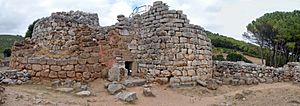Nuraghe facts for kids
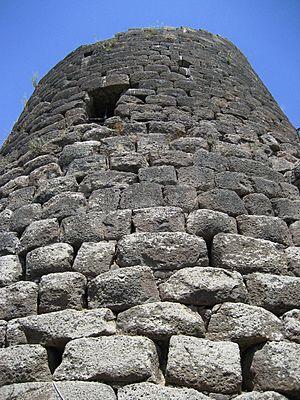
A nuraghe (say "noo-RAH-geh") is a special type of ancient stone building found only on the island of Sardinia. These huge stone structures were built during the Nuragic Age, which was a long time ago, between 1900 and 730 BC. Today, the nuraghe is a famous symbol of Sardinia and its unique culture, known as the Nuragic civilization. More than 7,000 nuraghes have been discovered, but experts believe there were once over 10,000 of them!
Contents
What's in a Name?
The word nuraghe is thought to come from old Sardinian words. Some people think it might be linked to words like nurra, which means 'a heap of stones' or 'a hole in the ground'. It's a bit of a mystery where the name truly came from!
How Nuraghes Were Built
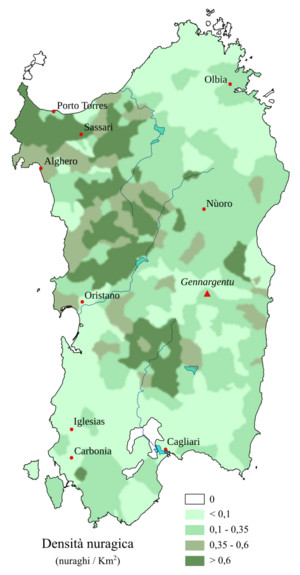
Most nuraghes look like a cone-shaped tower with the top cut off, a bit like a medieval castle tower. Inside, they often have a round room with a dome-shaped roof.
These buildings were incredibly strong. Their walls were made of three layers:
- An outer layer of large stones, getting smaller towards the top.
- An inner layer of smaller stones, forming the dome.
- A middle layer filled with tiny stones and dirt, making the whole structure very sturdy.
Nuraghes were built without any cement! They stand strong just because of the weight of their huge stones, some of which weigh many tons. Some nuraghes were very tall, reaching about 20 meters (60 feet). The tallest known, Nuraghe Arrubiu, was probably 25–30 meters high.
The entrance usually leads into a hallway. This hallway often has small rooms or niches on the sides. From there, you enter the main round chamber. Inside the thick walls, there was often a spiral stone staircase. This staircase led to upper floors or to the roof terrace. These stairs had small openings called embrasures to let in light. Some nuraghes had up to three domed rooms stacked on top of each other!
Today, fewer than 7,000 nuraghes are still standing. Many were destroyed over time by farming, building roads, or other human activities. You can find most nuraghes in the northwest and south-central parts of Sardinia.
What Were Nuraghes Used For?
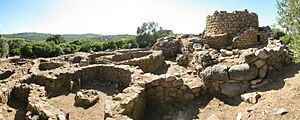
Scientists aren't completely sure what nuraghes were used for. They might have been:
- Homes for important leaders.
- Strong military forts.
- Places for meetings.
- Religious temples.
- Ordinary houses.
- Or even a mix of all these!
Many nuraghes are built on hills or in other important places. From these spots, people could easily watch over important paths. This suggests they might have been used for defense, acting as a warning to possible enemies. They could also have been a "status symbol," showing off wealth or power.
Some experts believe that the Nuragic people lived in independent communities, like small towns. They think that building these huge monuments might have shown who owned which areas.
Scientists have also studied the entrances of many nuraghes. They found that many entrances face the sunrise during the winter solstice (the shortest day of the year) or the moon when it rises furthest south. This suggests that the Nuragic people might have used the nuraghes to track the sun, moon, or even certain stars!
Different Kinds of Nuraghes
There are several types of nuraghes, each with slightly different features.
Protonuraghe
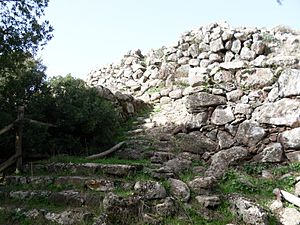
These are thought to be the oldest type of nuraghe. They look a bit more solid and less refined than the later ones. Protonuraghes usually have an irregular shape and don't have the big round room found in newer nuraghes. Instead, they have one or more long hallways or rooms.
Mixed Nuraghe
This type of nuraghe is a protonuraghe that was later changed or added to. This might have happened because people wanted to update the design or for other reasons.
Single-Tower Nuraghe

This is the most common type of nuraghe. It's a single, cone-shaped tower with a flat top. Inside, it has one or more rooms stacked on top of each other, each with a dome-shaped roof. The entrance usually leads to a hallway, which then goes into the main central room. A spiral staircase built inside the wall leads to the roof or upper rooms. These towers often have smaller rooms or niches inside too.
A "Tancadu" Nuraghe
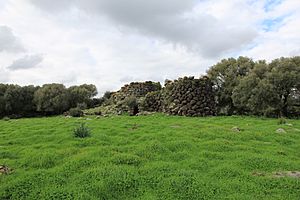
The word "tancadu" means "courtyard" in Sardinian. This type of nuraghe started as a single tower, but then another round building was added. Two walls connected these two buildings, creating a courtyard inside. Sometimes, these courtyards even had a well!
Polylobed Nuraghe
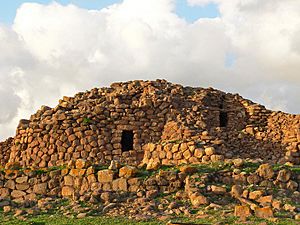
These are the most complex and rarest types of nuraghes. They are like huge fortresses with many towers connected by high walls. These "Megalithic castles" were built to create more useful space and to make the central tower even stronger. They were often surrounded by extra walls, sometimes with more towers.
Famous Nuraghes
Some nuraghes are so important that they are listed as UNESCO World Heritage Sites. Su Nuraxi di Barumini, in southern Sardinia, is one of the most famous. Another very tall and complex nuraghe is the Nuraghe Santu Antine near Torralba. Other well-known nuraghes include Nuraghe Palmavera near Alghero, Nuraghe Losa near Abbasanta, and Nuraghe Arrubiu near Orroli.
When Were They Built?
Nuraghes were built during the middle and late Bronze Age, roughly between the 18th and 15th centuries BC. Some similar buildings, called torri, are found in southern Corsica, and talaiots are found in Menorca and Majorca. These are the only buildings widely believed to be related to nuraghes.
An Italian archaeologist named Massimo Pallottino said that the buildings made by the Nuragic civilization were the most advanced in the western Mediterranean during that time. Even though there are 7,000 nuraghes still standing, only a few have been fully explored by scientists.
Images for kids
-
Nuraghe Arrubiu, Orroli
-
Nuraghe Santa Barbara, Macomer
-
Nuraghe Iloi, Sedilo
-
Nuraghe Oes, Giave
-
Nuraghe Ruiu, Chiaramonti
-
Nuraghe Orolio, Silanus
-
Nuraghe Santu Antine, Torralba
-
Nuraghe Loelle, Buddusò
-
Nuraghe Orolo, Bortigali
-
Nuraghe Nieddu, Codrongianos
-
Nuraghe Su Mulinu, Villanovafranca
See also
 In Spanish: Nuraga para niños
In Spanish: Nuraga para niños
- Ahwat
- Beehive tomb
- Broch
- Chullpa
- Giants' grave
- Girna
- Motillas
- Talaiot










